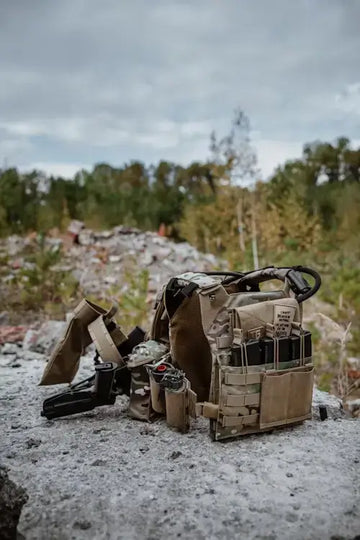
Body armor has come a long way over the centuries. From ancient chainmail to modern bulletproof vests, the quest for better protection has never stopped.
One of the most significant advancements in recent times is the Improved Outer Tactical Vest (IOTV). This game-changing innovation has set new standards in the field of personal protection. Let's explore how IOTV has transformed the landscape of body armor.
A Brief History of Body Armor
First, it's important to understand where we started. In ancient times, soldiers relied on metal armor, such as chainmail and plate armor. These offered some protection but were heavy and cumbersome.
For instance, a full suit of plate armor could weigh up to 60 pounds, significantly hindering movement and agility.
As firearms became more prevalent, the need for better protection grew.
Fast forward to the 20th century, and we see the introduction of flak jackets during World War II.
While they offered better mobility, they were still far from perfect. Flak jackets were bulky and provided limited protection against modern ballistic threats.
The Birth of Modern Body Armor
By the late 20th century, body armor saw significant improvements.
Kevlar, a high-strength synthetic fiber, revolutionized personal protection.
Bulletproof vests made from Kevlar were lighter and more effective at stopping bullets.
However, they still had limitations, especially against higher-caliber rounds and shrapnel.
Kevlar vests were primarily designed to stop handgun rounds, which meant they weren't fully reliable against rifle rounds or explosive fragments, posing a risk in combat situations.
Enter the IOTV
In the early 2000s, the U.S. military introduced the IOTV. This was a breakthrough.
Unlike its predecessors, the IOTV offered enhanced protection and greater comfort. So, what makes the IOTV so special?
Firstly, the IOTV is made from advanced materials that provide superior ballistic protection.
It uses a combination of Kevlar and ceramic plates. This ensures that it can stop high-velocity projectiles and shrapnel.
The integration of ceramic plates is crucial because they can dissipate the energy of a bullet, preventing penetration and reducing blunt force trauma.
Secondly, the IOTV is designed with modularity in mind.
Soldiers can add or remove components based on their mission needs. This includes additional armor plates, pouches, and other accessories.
This flexibility is a huge advantage in the field, allowing soldiers to adapt their gear to different combat scenarios and operational requirements.
Key Features of the IOTV
- Enhanced Protection: The IOTV provides protection against both ballistic threats and fragmentation. The inclusion of ceramic plates in vital areas, like the chest and back, adds an extra layer of defense.
This means that soldiers are better protected against a wider range of threats compared to older vests, which primarily relied on Kevlar alone.
The ceramic plates can stop high-velocity rifle rounds, which is essential in modern warfare.
- Improved Comfort: One of the biggest complaints about older vests was discomfort.
The IOTV addresses this with adjustable straps and padding.
This ensures a better fit and reduces fatigue during long missions.
Soldiers can move more freely and stay focused on their tasks without being distracted by an uncomfortable vest.
Additionally, the IOTV includes moisture-wicking materials that help keep soldiers cool and dry, further enhancing comfort during extended wear.
- Quick-Release System: In emergencies, every second counts. The IOTV has a quick-release system that allows soldiers to shed the vest rapidly.
This can be crucial in situations like vehicle rollovers or when treating injuries. The ability to quickly remove the vest can save valuable time and potentially lives.
This feature is especially important for medics and first responders who need to access wounds quickly.
Whether a soldier needs to carry extra ammunition, medical supplies, or communication devices, the IOTV can be configured to meet those needs.
The modular design also means that soldiers can reconfigure their loadout as mission requirements change, ensuring they are always prepared.
Real-World Impact
The introduction of the IOTV has had a significant impact on military operations. Soldiers report feeling more confident and secure wearing the vest. Its design also allows for better mobility.
For example, in Afghanistan, soldiers faced rugged terrain and unpredictable combat scenarios. The IOTV's versatility and reliability proved invaluable.
It provided the necessary protection while allowing soldiers to maneuver effectively, ultimately saving countless lives.
One notable example of the IOTV's effectiveness is its performance during patrols in urban environments.
Soldiers equipped with IOTVs have reported that the vest's modular design allows them to carry additional equipment needed for close-quarters combat, such as breaching tools and extra magazines.
This adaptability has made the IOTV a preferred choice for various operations, from open-field engagements to complex urban warfare.
Conclusion
In conclusion, the IOTV has truly changed the game in personal protection. Its combination of enhanced protection, comfort, and modularity sets it apart from previous body armor designs.
As technology continues to advance, we can expect even more innovations in this field.
For now, the IOTV remains a critical piece of equipment for modern soldiers, providing the protection they need in the most demanding environments.
With its advanced materials, thoughtful design, and real-world effectiveness, the IOTV exemplifies the evolution of body armor.
It not only meets the current needs of soldiers but also sets the stage for future advancements in personal protection.
As we look ahead, it's clear that the IOTV will continue to play a vital role in keeping our soldiers safe on the front lines.





